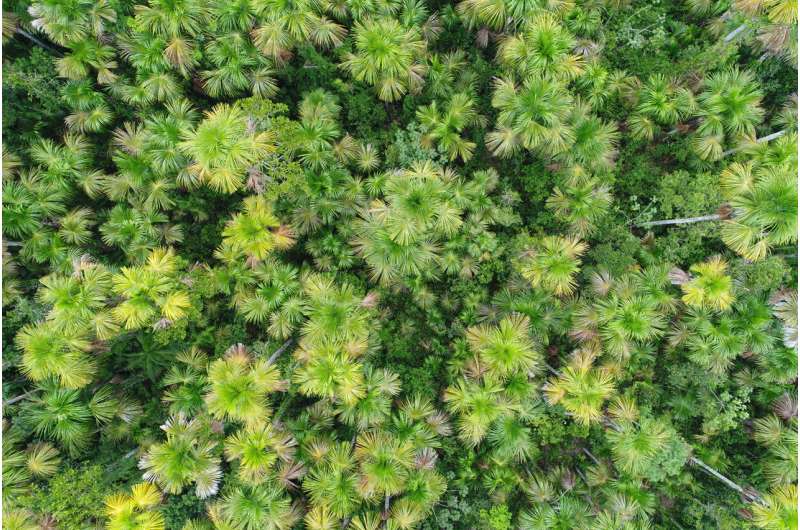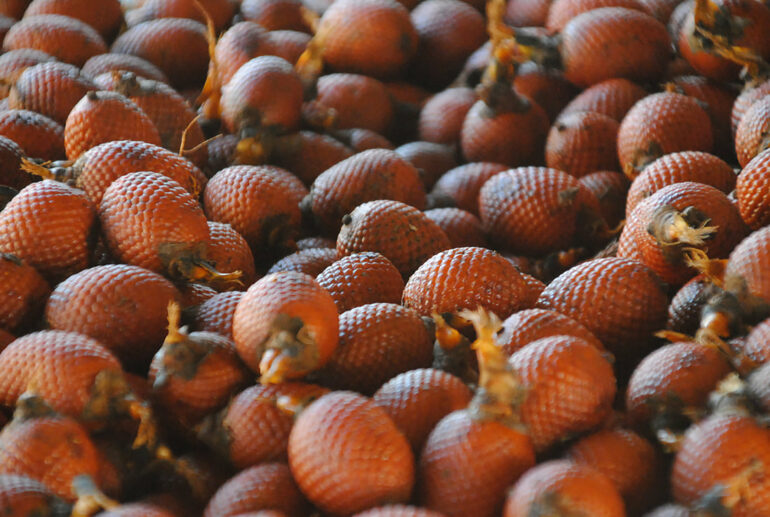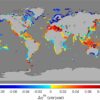Changing the way fruit is gathered from a “tree of life” could have hugely positive environmental and financial impacts in Amazonia, according to a new study.
An international research team, jointly led by the University Leeds and the Peruvian Amazon Research Institute (Instituto de Investigaciones de la Amazonia; IIAP) have shown for the first time the widespread harm caused in Peru by cutting down the palm tree Mauritia flexuosa in order to harvest its fruit.
The scientists examined where and why the trees were felled, producing detailed maps and analysis to reveal the extent of the environmental and economic damage caused by cutting down the palms.
Gabriel Hidalgo, lead author of the study who conducted the research as a postgraduate student at Leeds’ School of Geography whilst based at IIAP, said: “Cutting down female palm trees to harvest the fruit has halved the total production of fruit of this palm that is available to local communities.
“This is a clear example of the impact of humans on natural resource levels, in an ecosystem that, on first look, appears undamaged.
“However, changing the way the fruit is harvested can increase both the number of fruit-bearing palms trees, and the value of these Amazonian peatland ecosystems to people.”
Their study, published in Nature Sustainability, uses data from 93 sites across the palm swamp forests that are found on the extensive lowland tropical peatlands in north eastern Peru. Mauritia flexuosa is the most common species of tree in these peatland ecosystems that have the highest concentration of carbon of any part of the vast Amazon region.
The palm tree’s fruit, known as aguaje, is widely used in food and drink preparation, and is an important part of the north Peruvian economy. Where currently harvested, sale of its fruit represents 15–22 % of family incomes.
The species is dioecious—there are both female and male trees—with the female bearing the fruit.

Mauritia canopy. © Ximena Tagle
But because many of the female trees are cut down to harvest their fruit, many forests mostly contain male trees and therefore produce little fruit.
The research team discovered that the few places where an alternative harvesting method is employed—climbing the trees to gather the fruit—have a higher number of fruit-bearing female trees.
Climbing avoids killing the trees, which take about 10 years to reach maturity, growing up to 40 metres in height.
The research team, which also included scientists at the University of St Andrews and Wageningen University in The Netherlands, estimated that by switching to tree climbing to collect the fruit, the overall harvest could increase by 51%, and generate $62 million a year for the local economy.
Dennis del Castillo, head of the PROBOSQUES research group at IIAP said: “This study shows that financially, over the long term, the potential value of the palm fruit ‘aguaje’ for this region of Peru is similar in value to activities such as logging and oil extraction. Sustainable palm fruit harvesting could therefore provide a real economic alternative for local people.”
Increasing the value of these intact forests would also bring significant environmental benefits: globally, tropical peatlands are one of the most carbon-rich landscapes, and keeping this carbon in the ground is crucial for reducing the amount of greenhouse gases emitted into the atmosphere.
These forests also provide a wide range of resources and have high cultural value for indigenous communities and the fruit of Mauritia flexuosa, described as the “tree of life” by 19th century explorer Alexander von Humboldt, also provides a food source for birds, fish and mammals.
Co-author Dr. Euridice Honorio started measuring the proportion of female trees as an indicator of the impact of resource extraction on the health of these ecosystems while working at IIAP. Dr. Honorio, who is currently a NERC Knowledge Exchange Fellow on tropical peatlands at the University of St Andrews, said: “This is the first estimate of the total value of this resource to communities in this region and will help to promote sustainable fruit harvesting by communities.”
Tim Baker, Professor of Tropical Ecology and Conservation at Leeds’ School of Geography said: “Reducing deforestation of tropical forests is a global priority to mitigate climate change. Achieving success depends on increasing the value of standing forest to people who live in these landscapes. This study demonstrates a pathway to do this in one of the most carbon-rich landscapes on the planet.”
“Sustainable palm fruit harvesting as a pathway to conserve Amazon peatland forests” is published in Nature Sustainability.
More information:
Carlos Hidalgo Pizango, Sustainable palm fruit harvesting as a pathway to conserve Amazon peatland forests, Nature Sustainability (2022). DOI: 10.1038/s41893-022-00858-z. www.nature.com/articles/s41893-022-00858-z
Provided by
University of Leeds
Citation:
‘Tree of life’ could help slow climate change (2022, April 4)



